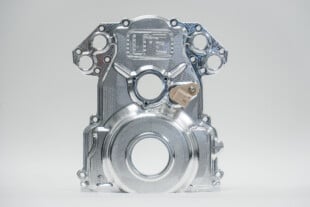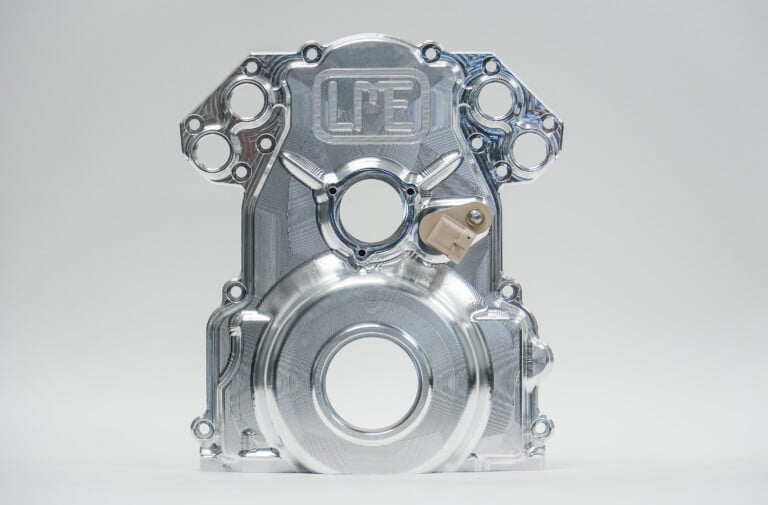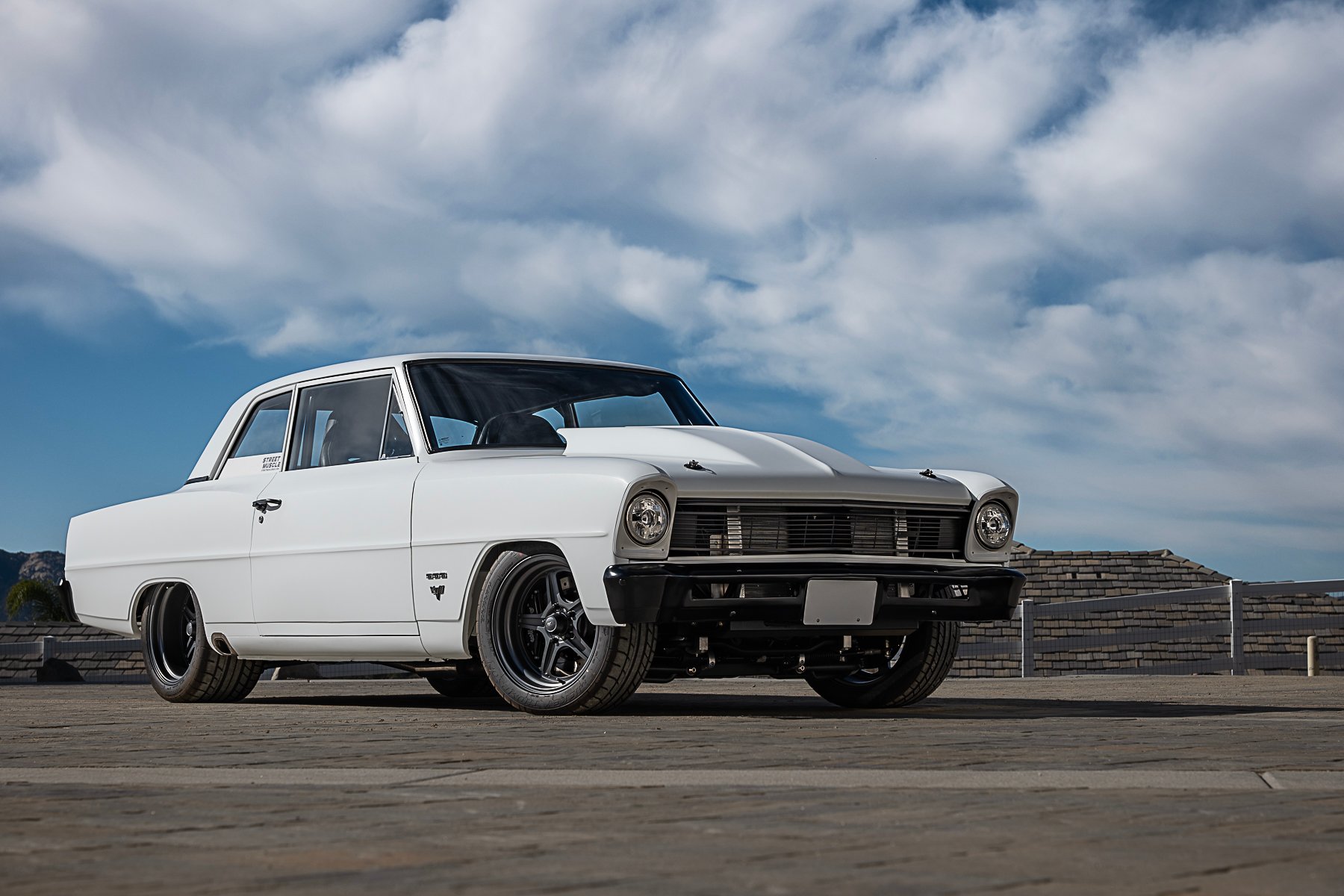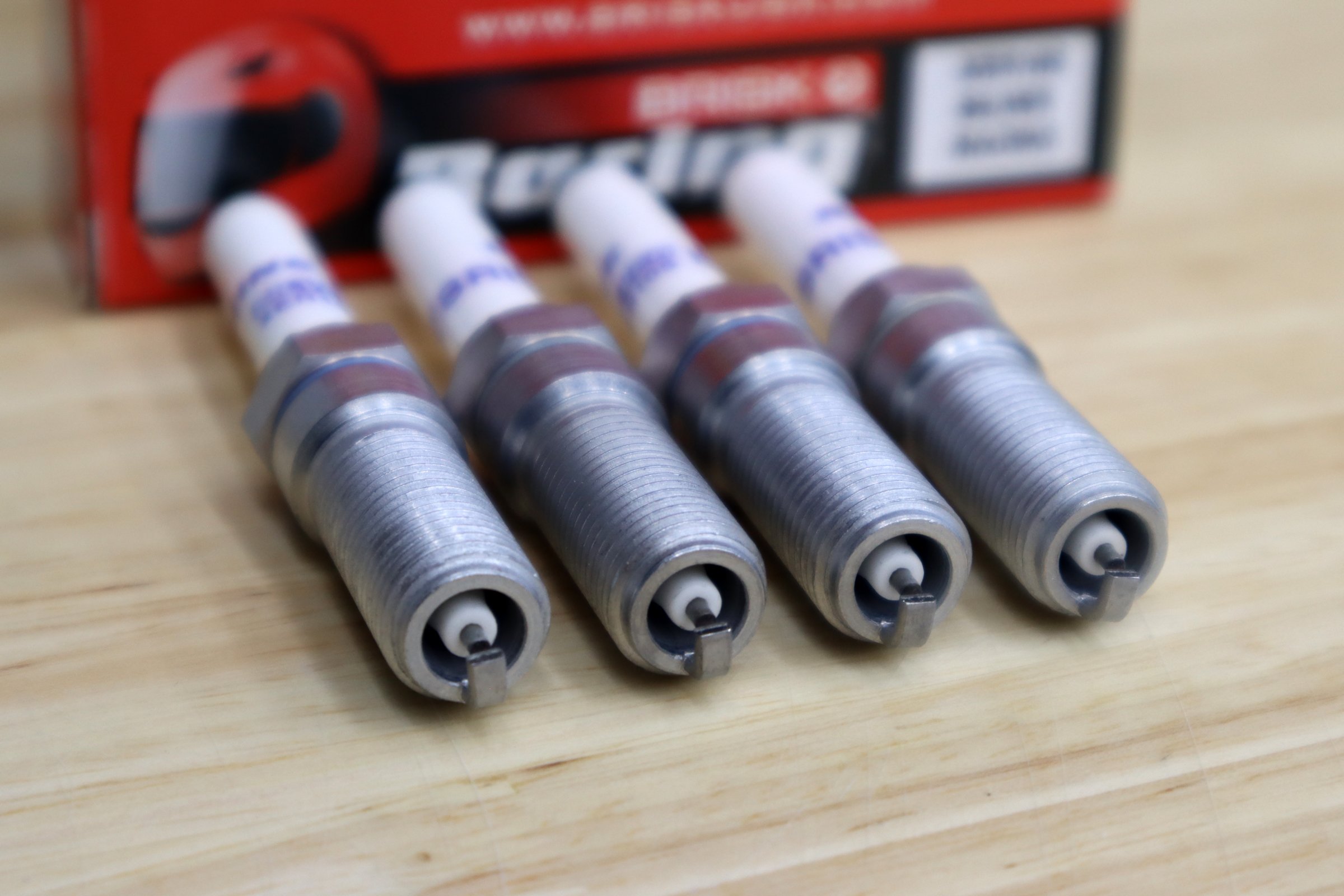Our All-Air Camaro project has already come a long way from the pitiful V6 stocker it left the factory with. But the hard work has only just begun, and with plans as ambitious as ours to turn this mild-mannered muscle car into a 9-second all-motor track monster, we needed some serious drag suspension. It just so happened that we had heard that Chassisworks had a trick new coil-over drag shock system that we wanted to try. We already had a full compliment of BMR suspension, but the great thing was the Chassisworks system worked just great with it. Let’s take a look!
As mentioned, we turned to Chris Alston’s Chassisworks for shocks and springs to help plant all this power to the ground. Chassiswork’s new trick F-Body Varishock system will provide our All Air Camaro with a bolt-in front coil-over conversion with dual adjustable shock valving, with a completely fabricated top shock mount that gets rid of all of the stock F-Body hardware in favor of a custom-designed coil-over configuration.
Think of it as a “Pro Stock” type front shock system for your F-Body.
Now, let’s get into the “meat” of the Chassisworks Coil-Over F-Body System….

Side by side of the stock-shock (bottom) and the new Varishock system (top). You can see that the stock shock assembly on the bottom includes an upper spring cup and a shock mounting location. On the Chassisworks, this is a true drag racing double-adjustable style shock. The difference is the custom upper shock mount system.

The coil-over conversion plugs right into the mount, fitting easily into the stock location with no fuss.
Chassisworks Upper Strut Mount
As you can see in the above picture, the Chassisworks Varishock coil-over shock is not a standard “F-body” style strut. It is designed to be used with the Chassisworks upper-mount assembly. On the lower side, the urethane-bushing cross bar mounts to the BMR (or stock) control arm. Included in this kit is:
Shocks: Chassisworks Varishocks are billet aluminum, and are available in 16-position single adjustable, and 256-position double adjustable. Your choice. For All-Air we picked double adjustable. The single adjustable package is $719.00 and the double adjustable kit is $919.00
Springs: Three coil-over rates are available for your coil springs ranging from 350 to 450 lb/in whether you are drag racing, driving on the street, want a handling ride, or something in between.
Hardware: Upper control arm mount, mounting hardware, spanner wrench, and complete instructions.

Chassisworks lower shock mount is identical to stock, except with a poly bushing. It bolted right into the BMR lower control arms.
A Little Background on Chassisworks
Alston struck out on his own with Chassisworks in 1987, wanting to provide cost effective, quality suspension components, especially for muscle cars. He has been heavily involved in the hobby since the early days of the muscle car wars. His first love was a ’66 Chevelle “which stayed stock for maybe a month,” he says. After a stint in jail for street racing, Chris began to focus on professional, sanctioned racing, having been scared straight in a manner of speaking. He started by building tube chassis race cars right out of high school. “I worked out of my garage and in my driveway. Back then it was just Gassers and Pro Stocks,” Alston says. Back then, people concentrated mostly on the engine aspect of racing, something Alston himself never got big into.
There was a lack of any real suspension components, even on the highest horsepower cars. “All we had back then was a single loop roll bar, slapper bar, and maybe some shocks,” he says. “If you wanted a chassis component, you had to build it yourself.” Seeing that there was a large, unexploited market, Alston dove in and began designing shock absorbers for drag cars alongside Koni in the late ‘70’s. A true pioneer in suspension components, Alston and his company have made suspension components for a number of prominent companies, leading the way by providing adjustable, quality, and easily accessible shocks and suspension components.
Having been in the sport so long, “I’ve lived through five or six evolutions of the sport,” he says. This is what has helped him stay in business so long and become an industry leader. “Our heritage and involvement in the sport go way back.”

Testing a Varishock on the Shock Dyno
Our Project: Why VariShocks
All-Air is a big, ambitious project (aren’t they all?), and we didn’t choose to go with the Varishock on a whim. This coil-over conversion features the VariShock which offers a lot of benefits over the Camaro’s clunky stock suspension as well as the exemplary craftsmanship that Chassisworks has built a reputation on. Coupled with the Varispring, this exclusive bolt-in coil-over conversion is an easy install that makes a big difference down the strip. Even better, it is an adjustable and affordable system that can be tuned and tweaked to the needs of hardcore and casual racers alike.

Close-up of the dual adjustable Varishock
All the technology in the world wouldn’t matter if it was a poorly built product, but the Varishock uses top-notch materials to ensure a long and useful life. For example, the upper and lower spring seats are made from billet aluminum, and fully gusseted sheet metal eliminates flexing while allowing for a double shear bolt arrangement. A zinc coating on the mounts helps prevent corrosion, which means even several years down the road these shocks should still look as good as the day they were put in. A clear anodize finish is applied to each shock as well to enhance corrosion resistance across the entire product.
An aluminum alloy is used to make the base valve mechanism to allow for more consistent flow characteristics, while also dissipating the heat caused by fluid travel within the shock better than other materials. Internal valves in the Varishock system further improve heat dissipation and allow for greater fluid control, which is necessary to the longevity and effectiveness of the shock itself. These valves are also exchangeable and customizable, depending on your needs.

The Varishock uses a high-density, inert gas that prevents mixing with the fluid which allows the Varishock to be mounted any which way, even completely inverted.
Which brings us to the real meat of the Varishock design, the dual adjustable settings that allows you to tinker with the compression and rebound of the shock, rather than rely on a factory-determined setting. There are 16 settings for both compression and rebound, which means there are a total of 256 different settings per shock, allowing All-Air to be tuned for whatever the situation may call for. But one of the biggest advantages to the Varishock is the location of the knobs. Since they are on the bottom, they are easily accessible. As Alston says, “If you can’t get to them easily you’re probably not going to adjust them.”
The best shock is only as good as its spring, and the Varispring was built to work hand-in-hand with the Varishock. It utilizes high tensile wire that is stronger than the chrome-silicon wire found is most other springs. This allows the spring to “set solid”, which means the coils can completely compress and touch without damaging the spring, thus affecting ride height. Varisprings are available in lengths between 7″ and 14″, with the amount of travel varying between 3.51″ and 10.28″. The springs we choose for All-Air were 12″ long, with a 450lb spring rate up front and allowing for 6.24″ of travel. And just like the other Varishock parts, the Varisprings and powder coated for a good, long-lasting look.
Pre-Installation Prep
Before we can even begin thinking about installation, there is a lot of clunky stock parts to remove first. To start with, we are using an all-new BMR LS1-turbo K-member to get rid of the bulky, heavy, and ugly stock k-member. With the engine out, removal was a cinch, and the new BMR K-member mounted to the stock bolt locations without giving us any problems, as did the new upper and lower A-arms, also from BMR. This tougher, better looking suspension will vastly improve the handling characteristics of our Camaro while at the same time giving the engine bay a clean, new look.
With the front suspension all hooked up, it was time to assemble our shocks and springs. The Varishock comes with all the parts needed including the Varispring, upper and lower spring seats, and vehicle-specific mounting hardware. As mentioned earlier, while the coil-over kit is a simple bolt-in affair, some assembly is required before hand. Luckily, Chassisworks has made this as simple as possible; all that is needed is patience and a bench vice.

Pushing in the polyurethane bushing.
To start with, our shop “Dawg” Bobby Kimbrough inserted the polyurethane bushing into the upper shock eye. The polyurethane bushing provides unsurpassed support and comfort for the shock and is quite hardy as well. Using the bench vice, he pressed the steel sleeve into the bushing with the help of some polyurethane grease. Patience is key here. Ensure the steel sleeve is properly aligned before pressing it in, because as hardy as the bushing is, the steel sleeve will easily slit or rip it if it is pressed in at a funky angle. Measure twice, cut once, as the old saying goes. The polyurethane grease makes the job a lot easier, so make sure you have some on hand before attempting this step, otherwise you are just asking for trouble.

Using a bench vice, slowly and carefully push the steel sleeve into the upper eye socket
The lower shock eye also has a polyurethane bushing, but has a two-piece crossbar that installs into the lower A-arm rather than a steel sleeve. Again, coat the crossbar in polyurethane grease before proceeding, and press one side of the crossbar into the bushing. Then slide a crush washer onto the other half of the crossbar, and thread the crossbars together until they are flat and tight.
With the bushings and bars out of the way, it’s time to move on to the spring seats. The lower spring sits on a threaded shock body and is fitted with two spring-loaded shock ball lock mechanisms to hold whatever adjustments you may make to the shock. Once the bars are installed, Bobby threaded the lower spring seat on easily.

Slipping the spring over the shock
With six individual notches on the spring seat itself, slip-free adjustments can be made to the spring with the Varishock four-tang spanner wrench (which comes with each kit). Bobby turned the lower spring seat down as far as it would go without hitting the adjustment knobs and then lightly greased the spring seat bearings before placing them in the spring seat. The Varispring slips down over the shock reservoir and sits snugly into the lower spring seat. Then the top spring seat was placed between the top of the spring and the upper shock eye, and then he tightened both spring seats down equally to prevent loading up the chassis.
The process was repeated for the other front shock and we were ready to hook them up to our Camaro.
Installation – Front Shocks
The best thing about the Varishock system is that the upper shock mounts bolt right up to the OEM shock tower locations. No drilling, no measuring, no headaches. This allows the rest of the coil over conversion to mount up easily. The kit comes with two bolts, lock nuts, and washers, and with engine out and the car on a lift, installation couldn’t be easier. Just bolt the mount to the OEM locations, and you’re ready to attach the shocks and springs. An aluminum shim is sandwiched between the lower crossbar and the lower A-arm’s mounting plate, but other than that hooking up the front shocks was as simple as turning a wrench. As a side note, the adjustment knobs should placed on the inside of the lower A-arm, making them easy to access.

Upper shock mounts. Trick, simple and effective.
A note to anyone planning on doing this coil-over conversion without access to a lift; ensure that your car is properly elevated and not just sitting on a jack, especially during the stock suspension removal. Even the slightest shift can cause an improperly-elevated car to fall, resulting in serious injury or death. We may make the job look easy, but that doesn’t mean we don’t take the proper precautions even on a simple task like this.
With the front shocks locked into the new BMR A-arms, we were ready to move on to the rear. With the parts from BMR, and the Chassisworks shocks, we felt extremely comfortable that we could apply maximum weight transfer with superior adjustability at the drag strip.
Installation – Rear Shocks
With a project such as All-Air, the stock rear end just isn’t going to do. Even if this was a stock SS Camaro, the factory rear ends are nothing special and would require replacement anyway. To that end, we got in touch with Moser, who sent us their M9 rear end housing, a new lightweight aluminum center section, and heavy-duty axles to handle all of the naturally aspirated power we’ll be throwing at it.
Again, with the Varishock being a bolt-in kit, there was little more to the installation than popping them up into the factory mounting points. Taking the old shocks out was a bit more of a maneuver however, requiring cutting of the carpet just behind the apex of the rear wheel wells. From there, Bobby was able to unbolt and remove the old shocks and slip the new shocks into position. They fit perfectly into the new Moser rear end which Moser equipped with F-Body suspension mounts.
In terms of adjustment tips, of course those vary for each race car or street car. Chassisworks is available to help you with your exact combination. They recommended for our project that on the front shocks, a good setting would be on the 1-2 range for compression (going up from there), and 4-5 on the rebound on the way back down. For the rear shocks, depending on your tire size and rear end configuration, anywhere in the mid-range (7-8) should be enough to keep the tires and power on the pavement for the first pass. Then you should change the setting at see what your setup likes.
The F-Body community has been waiting for a product like the F-Body Coil Over conversion for some time. Working in concert with a trick shock system like VariShock, this package at under $1,000 is a major steal. We will be sure to update you with track results and testing once we get our 800 hp all-motor F-body down the 1320.

The completed front suspension.





















